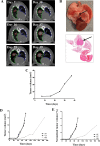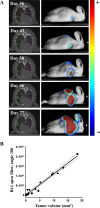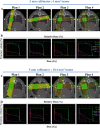An orthotopic non-small cell lung cancer model for image-guided small animal radiotherapy platforms
- PMID: 30465693
- PMCID: PMC6541189
- DOI: 10.1259/bjr.20180476
An orthotopic non-small cell lung cancer model for image-guided small animal radiotherapy platforms
Abstract
Methods:: An orthotopic non-small cell lung cancer model in NMRI-nude mice was established to investigate the complementary information acquired from 80 kVp microcone-beam CT (micro-CBCT) and bioluminescence imaging (BLI) using different angles and filter settings. Different micro-CBCT-based radiation-delivery plans were evaluated based on their dose-volume histogram metrics of tumor and organs at risk to select the optimal treatment plan.
Results:: H1299 cell suspensions injected directly into the lung render exponentially growing single tumor nodules whose CBCT-based volume quantification strongly correlated with BLI-integrated intensity. Parallel-opposed single angle beam plans through a single lung are preferred for smaller tumors, whereas for larger tumors, plans that spread the radiation dose across healthy tissues are favored.
Conclusions:: Closely mimicking a clinical setting for lung cancer with highly advanced preclinical radiation treatment planning is possible in mice developing orthotopic lung tumors.
Advances in knowledge:: BLI and CBCT imaging of orthotopic lung tumors provide complementary information in a temporal manner. The optimal radiotherapy plan is tumor volume-dependent.
Conflict of interest statement
Figures



References
MeSH terms
LinkOut - more resources
Full Text Sources
Medical

